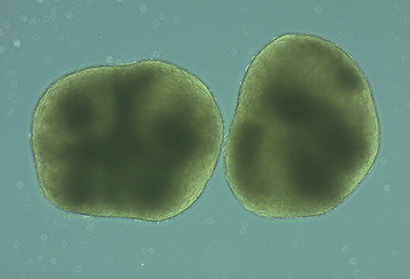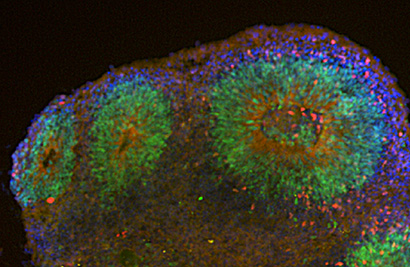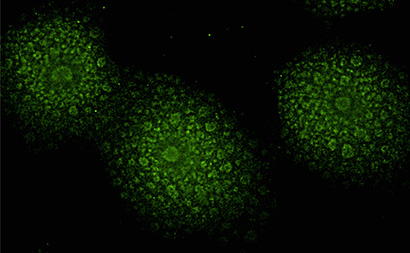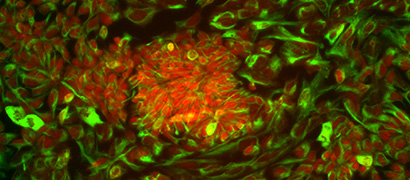The UC Santa Cruz Genomics Institute, in collaboration with neuroscience faculty at UC San Francisco, is launching an ambitious new project to learn how the human brain evolved and how its neural circuitry develops.
The project, funded by Schmidt Futures, involves applying modern artificial intelligence (AI) approaches to understanding and emulating the architecture of the human brain. A key part of the project is to advance the technology for growing and studying three-dimensional models of brain tissue, called cerebral organoids, in the laboratory.
Starting with human pluripotent stem cells, researchers can now grow cerebral organoids that are like small patches of cerebral cortex or other brain regions. Improving the technology for growing cerebral organoids will make this important research tool more powerful and more widely available, said David Haussler, professor of biomolecular engineering and scientific director of the UC Santa Cruz Genomics Institute at the Baskin School of Engineering.
"We want to scale up this technology to make larger numbers of more realistic models of the human cortex," Haussler said. "It will take a huge amount of work to develop this technology, but the questions we can ask are incredibly exciting, such as: What were the genetic changes in evolution that gave us our bigger and differently-wired brains? In other words, how did we become human?"
Genomic innovations
Haussler's team used cerebral organoids in experiments leading to a major discovery reported last year, in which his team identified three related genes found only in humans that play a critical role in the development of our large brains. But Haussler said the evolution of the human brain must have involved hundreds of other genetic changes.
One goal of the new project is to identify the full range of genomic innovations underlying the brain's evolution and to characterize the roles of those genes in brain development and function. Another goal is to develop the ability to create an electronic interface with cerebral organoids, allowing researchers to stimulate and monitor neural activity. Ultimately, the researchers hope to connect genetically modified organoids to computers to study how their neural circuits respond and adapt to stimuli.
UCSC research scientist Sofie Salama, whose lab led the earlier study, said the current limitations of cerebral organoids include the difficulty of controlling and monitoring how they develop over time. More advanced technology for growing and monitoring the organoids will enable researchers to perform more sophisticated experiments on a much larger scale.
"These are not going to be functional brains in a dish. But we can coax stem cells to make little patches of cerebral cortex that allow us to explore how the brain develops and how its neural circuitry works," Salama said. "This is extremely important for understanding neurodevelopmental diseases like schizophrenia and autism."
The team's collaborators at UCSF, neuroscientists Alexander Pollen and Tomasz Nowakowski, have developed strategies to use gene expression patterns and other molecular properties to identify and characterize all the different cell types present during human brain development. They were both involved in the UCSC team's discovery of human genes that affect brain size, and their labs are involved in the NIH-funded BRAIN Initiative and other large-scale consortium projects exploring human brain function.
Biomedical technology
Mircea Teodorescu, an associate professor of electrical and computer engineering at UC Santa Cruz, brings to the project expertise in biomedical engineering and flexible robotics. He is working with Salama's lab to develop better ways of growing cerebral organoids, using technologies such as 3D-printed scaffolding to support the developing organoid and microfluidic pumps and channels for nutrient delivery.
"We want to create a more realistic environment for growing cerebral organoids so they can develop much further than they do today," Teodorescu said. "We also want to develop stimulation and sensing techniques to initiate and monitor neural activity in the organoids."
Artificial neural networks, inspired by the neural architecture of the brain, are the basis of the highly successful machine learning algorithms used to develop speech recognition, image recognition, machine translation, and other AI applications. Haussler did influential work in the field of machine learning in the 1980s and 90s before turning his attention to bioinformatics. Now he wants to combine neuroscience and machine learning in new ways to advance the understanding of the human brain.
"The amazing thing about the brain is how it adapts and changes in the process of learning things. That's actual neural learning behavior, and artificial neural networks only very loosely mimic that," Haussler said. "The exciting thing about AI based on machine learning is that it's not programmed--it learns to do a task by changing the strength of artificial synapses to improve performance through billions of iterations. If we knew more about how the brain does this, we might be able to create more human-like AI."
By creating a system of wired cerebral organoids connected to an external AI program, the researchers hope to gain new insights into the patterns of neural activity in the developing cortex and how they change as neural circuits mature. "These insights will lead us to a better understanding of how our brains learn and adapt," Haussler said.






